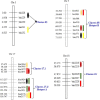Whole-genome mapping identified novel "QTL hotspots regions" for seed storability in soybean (Glycine max L.)
- PMID: 31208334
- PMCID: PMC6580613
- DOI: 10.1186/s12864-019-5897-5
Whole-genome mapping identified novel "QTL hotspots regions" for seed storability in soybean (Glycine max L.)
Abstract
Background: Seed aging in soybean is a serious challenge for agronomic production and germplasm preservation. However, its genetic basis remains largely unclear in soybean. Unraveling the genetic mechanism involved in seed aging, and enhancing seed storability is an imperative goal for soybean breeding. The aim of this study is to identify quantitative trait loci (QTLs) using high-density genetic linkage maps of soybean for seed storability. In this regard, two recombinant inbred line (RIL) populations derived from Zhengyanghuangdou × Meng 8206 (ZM6) and Linhefenqingdou × Meng 8206 (LM6) crosses were evaluated for three seed-germination related traits viz., germination rate (GR), normal seedling length (SL) and normal seedling fresh weight (FW) under natural and artificial aging conditions to map QTLs for seed storability.
Results: A total of 34 QTLs, including 13 QTLs for GR, 11 QTLs for SL and 10 QTLs for FW, were identified on 11 chromosomes with the phenotypic variation ranged from 7.30 to 23.16% under both aging conditions. All these QTLs were novel, and 21 of these QTLs were clustered in five QTL-rich regions on four different chromosomes viz., Chr3, Chr5, Chr17 &Chr18, among them the highest concentration of seven and six QTLs were found in "QTL hotspot A" (Chr17) and "QTL hotspot B" (Chr5), respectively. Furthermore, QTLs within all the five QTL clusters are linked to at least two studied traits, which is also supported by highly significant correlation between the three germination-related traits. QTLs for seed-germination related traits in "QTL hotspot B" were found in both RIL populations and aging conditions, and also QTLs underlying "QTL hotspot A" are identified in both RIL populations under artificial aging condition. These are the stable genomic regions governing the inheritance of seed storability in soybean, and will be the main focus for soybean breeders.
Conclusion: This study uncovers the genetic basis of seed storability in soybean. The newly identified QTLs provides valuable information, and will be main targets for fine mapping, candidate gene identification and marker-assisted breeding. Hence, the present study is the first report for the comprehensive and detailed investigation of genetic architecture of seed storability in soybean.
Keywords: High-density linkage map; QTL; Seed aging; Seed storability; Soybean.
Conflict of interest statement
The authors declared that they have no competing interests.
Figures


Similar articles
-
High-Resolution Mapping in Two RIL Populations Refines Major "QTL Hotspot" Regions for Seed Size and Shape in Soybean (Glycine max L.).Int J Mol Sci. 2020 Feb 4;21(3):1040. doi: 10.3390/ijms21031040. Int J Mol Sci. 2020. PMID: 32033213 Free PMC article.
-
Genome-Wide Detection of Major and Epistatic Effect QTLs for Seed Protein and Oil Content in Soybean Under Multiple Environments Using High-Density Bin Map.Int J Mol Sci. 2019 Feb 23;20(4):979. doi: 10.3390/ijms20040979. Int J Mol Sci. 2019. PMID: 30813455 Free PMC article.
-
Mapping of the genomic regions controlling seed storability in soybean (Glycine max L.).J Genet. 2014 Aug;93(2):365-70. doi: 10.1007/s12041-014-0381-0. J Genet. 2014. PMID: 25189231
-
Hotspot Regions of Quantitative Trait Loci and Candidate Genes for Ear-Related Traits in Maize: A Literature Review.Genes (Basel). 2023 Dec 21;15(1):15. doi: 10.3390/genes15010015. Genes (Basel). 2023. PMID: 38275597 Free PMC article. Review.
-
Molecular mapping and genomics of soybean seed protein: a review and perspective for the future.Theor Appl Genet. 2017 Oct;130(10):1975-1991. doi: 10.1007/s00122-017-2955-8. Epub 2017 Aug 11. Theor Appl Genet. 2017. PMID: 28801731 Free PMC article. Review.
Cited by
-
Insights into mechanisms of seed longevity in soybean: a review.Front Plant Sci. 2023 Jul 21;14:1206318. doi: 10.3389/fpls.2023.1206318. eCollection 2023. Front Plant Sci. 2023. PMID: 37546268 Free PMC article. Review.
-
Genome-wide analysis of cold imbibition stress in soybean, Glycine max.Front Plant Sci. 2023 Aug 21;14:1221644. doi: 10.3389/fpls.2023.1221644. eCollection 2023. Front Plant Sci. 2023. PMID: 37670866 Free PMC article.
-
Identification of hub genes regulating seed germination viability in soybean via comparative transcriptome analysis and WGCNA.BMC Plant Biol. 2025 Jul 3;25(1):861. doi: 10.1186/s12870-025-06833-y. BMC Plant Biol. 2025. PMID: 40610855 Free PMC article.
-
Multi-Locus Genome-Wide Association Studies Reveal Fruit Quality Hotspots in Peach Genome.Front Plant Sci. 2021 Feb 25;12:644799. doi: 10.3389/fpls.2021.644799. eCollection 2021. Front Plant Sci. 2021. PMID: 33732279 Free PMC article.
-
QTL mapping of PEG-induced drought tolerance at the early seedling stage in sesame using whole genome re-sequencing.PLoS One. 2021 Feb 24;16(2):e0247681. doi: 10.1371/journal.pone.0247681. eCollection 2021. PLoS One. 2021. PMID: 33626101 Free PMC article.
References
-
- Zhou Z, Jiang Y, Wang Z, Gou Z, Lyu J, Li W, Yu Y, Shu L, Zhao Y, Ma Y, Fang C, Shen Y, Liu T, Li C, Li Q, Wu M, Wang W, Wu Y, Dong Y, Wan W, Wang X, Ding Z, Gao Y, Xiang H, Zhu B, Lee S, Wang W, Tian Z. Resequencing 302 wild and cultivated accessions identifies genes related to domestication and improvement in soybean. Nat Biotechnol. 2015;33:408–414. doi: 10.1038/nbt.3096. - DOI - PubMed
-
- Schulte LA, Niemi J, Helmers MJ, Liebman M, Arbuckle JG, James DE, Kolka RK, O’Neal ME, Mark D, Tomer MD, Tyndall JC, Asbjornsen H, Drobney P, Neal J, Ryswyk GV, Witte C. Prairie strips improve biodiversity and the delivery of multiple ecosystem services from corn–soybean croplands. Proc Natl Acad Sci USA. 2017;114:11247–11252. doi: 10.1073/pnas.1620229114. - DOI - PMC - PubMed
-
- Yang F, Wang X, Liao D, Lu F, Gao R, Liu W, Yong T, Wu X, Du J, Liu J, Yang W. Yield response to different planting geometries in maize–soybean relay strip intercropping systems. Agron J. 2015;107(1):296–304. doi: 10.2134/agronj14.0263. - DOI
MeSH terms
Substances
Grants and funding
LinkOut - more resources
Full Text Sources

